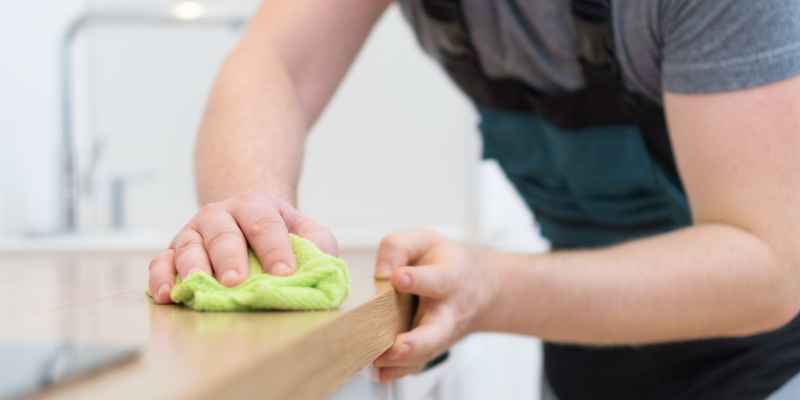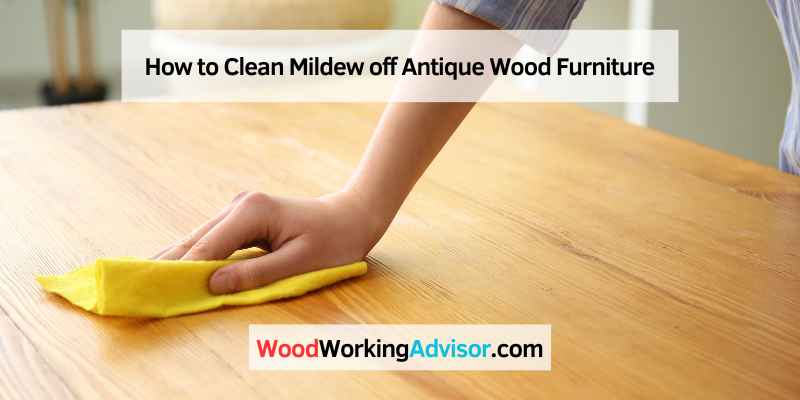Mildew can be a complex problem to solve, especially when it comes to antique wood furniture. If you’re dealing with mildew on your antique wood furniture, there are a few things you can do to clean it off and prevent it from coming back. First, start by cleaning the furniture’s surface with a damp cloth.
Be sure to dry the surface entirely afterward. Next, apply a solution of equal vinegar and water to the affected areas. Allow this to sit for several minutes before wiping it away with a clean cloth.
If the mildew is still present, you may need to repeat this process or use a more robust bleach solution and water.
Housekeeping Tips: How Do You Clean Mold From Wood Furniture?
- If the mildew is fresh, mix equal parts vinegar and water in a bowl
- Apply the mixture to the affected area with a cloth and scrub gently
- Rinse the area with clean water and dry thoroughly
- If the mildew is stubborn or has been on the furniture for some time, mix one part bleach with four parts water in a bowl
- Apply the mixture to the affected area with a cloth and scrub gently
- Rinse the area with clean water and dry thoroughly

Credit: restorationsecrets.com
White Mold Growing on Antique Furniture
White mold is a type of fungus that can grow on a variety of surfaces, including wood. While it’s not necessarily harmful to humans, it can cause damage to your antique furniture. You must take action immediately if you see white mold growing on any of your pieces.
Here are some tips for dealing with white mold:
1. Remove the affected item from your home. This will help prevent the spread of mold.
2. Clean the item with a solution of bleach and water. You may need to scrub vigorously to remove all the mold spores.
3. Dry the item entirely before returning it to your home.
Mold thrives in damp environments, so ensure your furniture is completely dry before putting it back in your house.
Mildew on Wood Furniture Vinegar
Vinegar can be a great natural solution if you have mildew on your wood furniture. Mix vinegar and water in a spray bottle and spritz the affected areas. Let it sit for a few minutes before wiping it away with a clean cloth.
You may need to repeat this process several times to eliminate all the mildew.
Cleaning Mold off Antique Furniture
Mold can be a complex problem to solve, especially when it comes to antique furniture. If you have mold on your antique furniture, there are a few things you can do to clean it off and keep it from coming back. First, start by cleaning the furniture’s surface with a damp cloth.
This will remove any dirt or dust that may provide the mold’s food. Next, use a vinegar solution to kill the mold spores. You can make this solution by mixing one part vinegar with three parts water.
Use a cloth soaked in this solution to scrub away the moldy areas. Once you’ve removed as much mold as possible, dry the area with a clean towel. Then, apply a thin layer of oil-based paint or varnish over the affected areas.
This will create a barrier that will prevent new mold spores from taking hold.
How to Clean Mildew off Wood Furniture
Mildew is a fungus that can grow on almost any surface, including wood furniture. While mildew isn’t necessarily harmful to humans, it can cause damage to your table if left unchecked. If you notice any mold on your wood furniture, cleaning it off as soon as possible is essential.
There are a few different ways to clean mildew off of wood furniture. One way is to mix equal parts white vinegar and water in a spray bottle and then use this solution to scrub the affected areas. Another way is to make a paste out of baking soda and water and use this to clean the mildew away.
Whichever method you choose, be sure to rinse the area well with clean water afterward. Once you’ve cleaned the mildew off your wood furniture, please take steps to prevent it from returning. This includes keeping your furniture clean and dry (especially if it’s kept in damp areas like basements or bathrooms) and using mold-resistant products when cleaning or storing your furniture.
Is Mold on Wood Furniture Dangerous
Mold can be a severe problem in any home, and it’s essential to be aware of its dangers. Mold on wood furniture is hazardous because it can release spores into the air that can cause respiratory problems for people with allergies or asthma. In some cases, mold exposure can even lead to death.
If you suspect that there is mold growing on your furniture, it’s essential to have it removed by a professional as soon as possible.
How Do You Remove Mold And Mildew from Antique Furniture?
If you have antique furniture that has become stained or discolored from mold and mildew, you can do a few things to clean it. First, try wiping the affected area with a damp cloth. You can use a weak bleach solution and water if this doesn’t work.
Be sure to test the solution on an inconspicuous furniture area first to ensure it won’t damage the finish. If the bleach solution does not work, you may need to sand down the affected area and refinish it.
How Do You Remove Mildew from Wooden Furniture?
Mildew is a fungus that can grow on various surfaces, including wood furniture. While mildew is not necessarily harmful to humans, it can cause damage to the surface it’s growing on. If untreated, mold can discolor wood furniture and make it more susceptible to rot and decay.
There are several ways to remove mildew from wooden furniture. One way is to mix equal parts white vinegar and water in a spray bottle and use it to clean the affected areas. Another way is to make a paste out of baking soda and water and use that to scrub the mildew away.
You can also try using hydrogen peroxide or bleach, but be sure to test these solutions on a small area first, as they may damage the finish of your wood furniture. Once you’ve removed all the mildew, clean the affected areas with soap and water. You may also want to apply a sealant or varnish over bare wood to help protect it from future growth of mold or mildew.
Can You Use Vinegar on Antique Wood?
If you are considering using vinegar on antique wood, it is essential to do your research first. While vinegar can be an effective cleaning agent, it can also cause damage to certain types of wood. Antique wood furniture is often delicate and may be more susceptible to damage from vinegar.
Before proceeding with any cleaning, testing a small furniture area is essential. If you use vinegar, dilute it with water and avoid using it at full strength.

What Kills Mildew And Mold on Wood?
Mold and mildew are fungi that grow on wood surfaces in damp, humid conditions. They can cause staining and discoloration of the wood, and in some cases, they can also cause structural damage to the wood. Mold and mildew are typically removed using cleaning and disinfecting agents.
Some common household cleaners that can remove mold and mildew from wood surfaces include bleach, vinegar, hydrogen peroxide, and baking soda. When using any of these cleaners, it is essential to follow the manufacturer’s instructions carefully. The cleaner should be applied to the affected area with a brush or cloth, left to sit for some time according to the instructions, and then wiped away.
The area should then be rinsed with clean water. Once the mold and mildew have been removed from the surface of the wood, it is essential to take steps to prevent their return. This includes ensuring the area is well-ventilated and free from dampness or humidity.
If possible, a dehumidifier should be used in rooms where mold or mildew is likely to occur (such as basements). Wood surfaces should also be cleaned regularly with suitable cleaners; this will help to remove dirt or debris that could provide food for mold or mildew spores.
Conclusion
Mix one vinegar with water to clean the mildew off of antique wood furniture. Next, dab the mixture onto the affected areas using a soft cloth and scrub gently. Finally, rinse the area with clean water and dry it thoroughly.



13 thoughts on “How to Clean Mildew off Antique Wood Furniture”